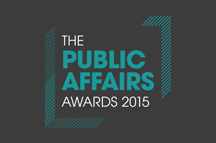Best Campaign in Scotland
Campaign: Knockshinnoch Wind Farm: Generating support
The 2015 Public Affairs Awards are dedicated to celebrating the best work that the Public Affairs industry has to show. As Media Partner, PubAffairs will be highlighting the entries of finalists in a number of categories.
The below entry is Pagoda Porter Novelli's submission in the Best campaign in Scotland category.
Brief and objectivesREG Windpower needed to secure planning consent for a two-turbine wind farm in East Ayrshire, between the two villages of Patna and Rankinston. The initial consultation period revealed 74% of the local community was in favour of the proposals and, as it met local planning policy, the development could have been automatically approved by council officials. Once the planning application was submitted in July 2014, Knockshinnoch Wind Farm attracted the attention of a national anti-wind group, which generated enough objection letters to trigger a hearing. Pagoda Porter Novelli was tasked with turning our silent majority of supporters into a vocal one, changing ‘neutrals’ into supporters and ensuring anti-wind campaigners living many miles from the site didn’t jeopardise the development for our client or the people of Patna and Rankinston . With a planning committee hearing scheduled for October 2014, we had to move fast to generate official support letters from the community. Research and planning
We examined the tactics of main opposition group, noting they made it extremely easy and convenient for people to object to applications across Scotland. We had to make it just as easy for people in Patna and Rankinston to make their support known to the council. With an initial committee date set for October 2014, our attention focused on getting as much official support to the council’s planning committee and the local ward members as possible. We knew that some people locally were on the fence – they had heard negative things about wind energy, were concerned about the impact of noise or the efficiency of turbines. We had to demonstrate the positive impact of onshore wind, allay concerns and turn a neutral individual into a supporter who would lobby the council on our behalf. Strategy and tacticsOnce the planning application was submitted in June 2014, we spent time in the local community building up our contacts, speaking to local residents and directly addressing any concerns or misunderstandings about wind energy. Our objective was to get as many letters of support in to East Ayrshire Council as possible and have local people lobby their elected officials in favour of the development. Our strategy was to:
Tactics included direct engagement, trips and events and using third-party information to strengthen messages. ImplementationThe activity ran from July 2014, when the planning application was submitted, until January 2015, when the application was approved by East Ayrshire Council’s planning committee. Wind farm trip We identified a group of local people who had concerns about a local wind farm, specifically about noise and appearance. We researched wind farms within a 90-minute drive of the area, consulted with residents about suitable days and times and then organised a coach trip to Whitelee, Scotland’s largest wind farm. The trip provoked a real change in people’s opinions. 92% said they were ‘more positive’ about wind farms in general, 60% said turbines were ‘quieter than expected’ and 40% said they were ‘visually better’ than expected. Speaking directly to the people of Patna and Rankinston We met regularly with community groups and built positive relationships with a number of residents. One woman jokingly remarked to our client that she spoke to our account executive more than she spoke to her daughter. Most importantly, we addressed concerns about the project as quickly as possible and were frank and honest with local people. We distributed third party publications including: Scottish Renewables’ Onshore Wind: What you need to know booklet, so they didn’t need to take our word about the benefits. The distinct role and results of public affairs lobbyingRaising awareness or getting media coverage wasn’t going to deliver the results our client wanted. We needed to contact elected officials directly and we ensured that local people lobbied effectively on our behalf. Making it easy for them to support us We devised an e-campaign that provided supporters with the planning application reference, instructions on how to support and contact details for local councillors and members of the planning committee. For those without email, we telephoned or wrote to them and helped them submit support by providing contact details, or asked one of our local supporters to pop in and see them. Briefing councillors We sent councillors two-page summaries ahead of committee meetings to ensure they had the correct information and could view, at a glance, the planning merits and economic benefits of Knockshinnoch, as well as the local support. Demonstrating tangible benefits to the communityRankinston’s community centre was at constant threat of closure and local people across all the villages felt that looming council cuts would further affect the services offered in these relatively remote areas. Knockshinnoch Wind Farm was a small proposal with huge potential benefits for the local area. The project would generate £20,000 each year for local communities, which we agreed would be split three ways. In addition, it would provide enough renewable energy to meet the annual needs of around 1400 households. Measurement and evaluationWe had between July 2014 and October 2014 to generate greater support than objection for Knockshinnoch wind farm and convince planning committee members to vote in favour.
|














.gif) Our research showed the majority of local people were in support of Knockshinnoch. During the consultation period, support increased from 56 to 74 percent and opposition was at 40 percent.
Our research showed the majority of local people were in support of Knockshinnoch. During the consultation period, support increased from 56 to 74 percent and opposition was at 40 percent.